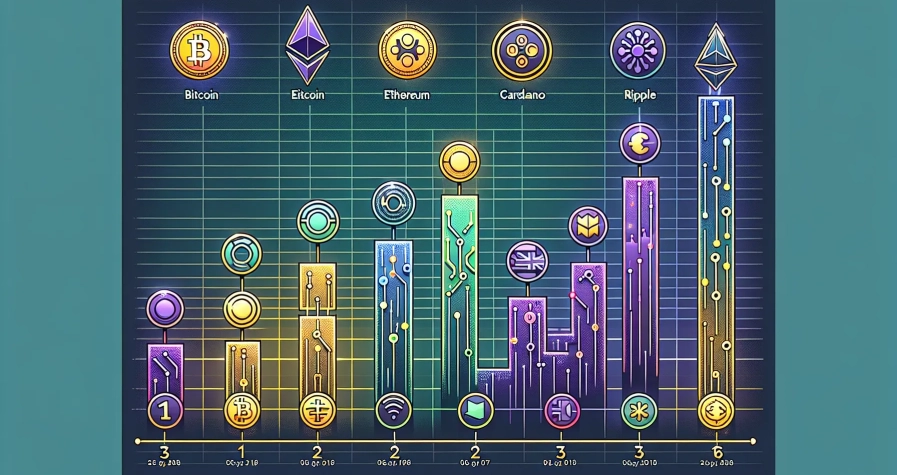Building a cryptocurrency portfolio from scratch can feel overwhelming. With thousands of tokens vying for attention and headlines swinging between euphoria and doom, new investors often freeze up or, worse, jump into speculative coins chasing rapid gains. But there’s a more sensible path: constructing a beginner portfolio around major cryptocurrencies, the large-cap, battle-tested assets that have survived market cycles and earned their place at the top.
Major cryptos offer beginners something rare in this space: a degree of relative safety. They’re not immune to volatility, nothing in crypto is, but their size, liquidity, and track record make them far less risky than the thousands of smaller, unproven tokens flooding exchanges. Think of them as the blue-chip stocks of the crypto world. They won’t deliver overnight riches, but they provide a sturdy foundation that won’t crumble at the first sign of market turbulence.
This guide walks through how to build a bulletproof beginner portfolio using only major cryptos. It covers what makes a coin “major,” which assets deserve a spot, how to allocate funds sensibly, and the practical steps for getting started, all whilst keeping risk in check.
Key Takeaways
- Building a beginner portfolio around major cryptos like Bitcoin and Ethereum offers greater stability and lower risk than chasing speculative altcoins.
- A conservative allocation of 70% Bitcoin, 20% Ethereum, and 10% other majors provides a solid foundation for crypto beginners.
- Dollar-cost averaging through regular contributions removes timing risk and builds discipline in volatile markets.
- Major cryptocurrencies are defined by large market capitalisation, deep liquidity, and proven track records spanning multiple market cycles.
- Effective risk management—including investing only what you can afford to lose and using secure storage—protects your beginner portfolio from catastrophic losses.
- Diversifying across Bitcoin for stability and Ethereum for smart contract exposure creates a bulletproof beginner portfolio positioned for long-term growth.
Why Major Cryptos Are the Foundation of a Beginner Portfolio

When someone’s new to crypto, the temptation to chase moonshots is real. Social media buzzes with stories of obscure tokens that 100x’d in a week, and it’s easy to think that’s the norm. It isn’t. For every winner, there are dozens of projects that vanish, rug-pull, or simply fade into irrelevance. Major cryptos, by contrast, offer a far more stable entry point.
Lower risk and volatility sit at the heart of why beginners should start here. Large-cap cryptocurrencies like Bitcoin and Ethereum experience price swings, certainly, but those swings are generally less extreme than the wild gyrations seen in smaller altcoins. They’ve weathered bear markets, regulatory scrutiny, and technological challenges. That resilience matters when you’re learning the ropes and can’t afford catastrophic losses.
Greater liquidity is another critical advantage. Major cryptos trade in enormous volumes across virtually every exchange. This means you can buy or sell at any time without worrying about slippage or thin order books driving prices against you. For a beginner, that ease of entry and exit is reassuring, it means your capital isn’t trapped.
Finally, major cryptos come with an extensive track record. Bitcoin has been running since 2009: Ethereum since 2015. Both have proven network stability, active development communities, and broad institutional interest. When you’re starting out, backing assets with years of operational history reduces the guesswork. You’re not betting on a whitepaper and a promise, you’re investing in infrastructure that’s already proven itself under fire.
In short, major cryptos form the bedrock of a sensible beginner portfolio. They won’t make you a millionaire overnight, but they significantly reduce the odds of a total wipeout.
Understanding What Makes a Cryptocurrency ‘Major’
Not every coin with a recognisable name qualifies as a “major” cryptocurrency. The term refers to a specific subset of digital assets characterised by size, stability, and staying power. Two key factors separate major cryptos from the pack.
Market Capitalisation and Liquidity
Market capitalisation is the most straightforward indicator. It’s calculated by multiplying the current price by the circulating supply, giving a snapshot of a coin’s total market value. Major cryptos are those in the large-cap category, assets with market caps measured in the tens or hundreds of billions of pounds. Bitcoin and Ethereum dominate this tier, and a handful of others (like BNB, Cardano, and Solana) have occasionally joined the ranks, though their positions can shift.
Why does market cap matter? Because it reflects both adoption and resilience. A coin with a £100 billion market cap has weathered significant market forces, attracted institutional and retail interest, and demonstrated that it fills a real need or use case. It’s far harder to manipulate or collapse than a coin with a £10 million valuation.
Liquidity goes hand in hand with market cap. Major cryptos enjoy high trading volumes across most exchanges, meaning there are always buyers and sellers ready to transact. This depth of liquidity ensures you can enter or exit positions without dramatically moving the price. For beginners, this is crucial, it means you’re not stuck holding an asset you can’t sell when you need to.
Track Record and Network Stability
Market cap alone doesn’t tell the whole story. A cryptocurrency also needs a proven track record and network stability. Bitcoin has operated continuously for over 15 years without a single major network failure. Ethereum has successfully executed complex upgrades, including its transition to proof-of-stake. Both have survived hacks, forks, regulatory challenges, and multiple market crashes.
Network stability encompasses security, uptime, and community support. Major cryptos are backed by robust, decentralised networks with thousands of nodes and active developer communities. They’re less vulnerable to single points of failure or abandonment by their creators.
In practice, a “major” crypto is one that combines large market cap, deep liquidity, and a long, stable operational history. These factors together signal reduced risk, exactly what beginners need.
The Core Major Cryptos for Your Portfolio
Once the criteria are clear, the question becomes: which coins actually qualify? A handful of cryptocurrencies consistently meet the “major” standard and deserve consideration in a beginner portfolio.
Bitcoin as Your Portfolio Anchor
Bitcoin (BTC) is the undisputed heavyweight. It’s the oldest, most widely recognised, and most liquid cryptocurrency in existence. Institutions hold it, governments debate it, and retail investors worldwide treat it as a store of value, a sort of “digital gold.” For beginners, Bitcoin serves as the anchor of a crypto portfolio.
Why anchor on Bitcoin? Because it has the strongest network effect, the highest security, and the clearest narrative. It’s not trying to do everything: it does one thing exceptionally well: serve as a decentralised, censorship-resistant form of money. That singular focus has kept it relevant through every market cycle.
Bitcoin’s volatility is still higher than traditional assets, but it’s lower than most altcoins. And its dominance in the market means that when crypto moves, Bitcoin often leads. For a beginner building their first portfolio, a substantial allocation to Bitcoin reduces overall risk whilst maintaining meaningful exposure to the space.
Ethereum for Smart Contract Exposure
If Bitcoin is digital gold, Ethereum (ETH) is the backbone of decentralised applications. Launched in 2015, Ethereum introduced smart contracts, self-executing code that powers everything from decentralised finance (DeFi) to non-fungible tokens (NFTs) to decentralised autonomous organisations (DAOs).
For a beginner, Ethereum offers exposure to the broader Web3 ecosystem. It’s not just a currency: it’s a platform. Thousands of projects are built on Ethereum, and its developer community is the largest in crypto. The network’s successful transition to proof-of-stake in 2022 demonstrated its ability to evolve and adapt.
Ethereum carries slightly more risk than Bitcoin, it’s more complex, faces more competition, and its price can be more volatile. But it’s also more closely tied to innovation in the space. A balanced beginner portfolio typically includes a meaningful Ethereum allocation alongside Bitcoin.
Other Established Major Cryptos to Consider
Beyond Bitcoin and Ethereum, a few other cryptocurrencies have earned major status, though they come with higher risk and should be treated as secondary holdings.
- BNB (Binance Coin): The native token of the Binance exchange and BNB Chain. It benefits from Binance’s massive user base and ecosystem, but its centralisation and regulatory scrutiny pose risks.
- Cardano (ADA): A proof-of-stake blockchain focused on academic rigour and slow, methodical development. It has a loyal community but lags behind Ethereum in adoption.
- Solana (SOL): Known for high throughput and low transaction costs, Solana has attracted significant developer and user interest. It’s also experienced network outages, which raise questions about long-term stability.
These coins can add diversification and growth potential, but they shouldn’t dominate a beginner’s portfolio. They’re best used in smaller allocations to round out exposure beyond the BTC-ETH core.
Optimal Allocation Strategy for Beginners
Knowing which cryptos to hold is only half the battle. The other half is deciding how much of each to hold. Allocation strategy is where risk tolerance meets portfolio construction, and getting it right can mean the difference between steady growth and sleepless nights.
Conservative vs Balanced Approaches
Beginners typically benefit from one of two allocation strategies: conservative or balanced.
A conservative portfolio prioritises stability and capital preservation. It might look like this:
- 70% Bitcoin: The largest allocation goes to the most stable, liquid, and established crypto.
- 20% Ethereum: A meaningful stake in the smart contract ecosystem without overexposure.
- 10% Other majors: A small slice for BNB, Cardano, Solana, or a mix, providing slight diversification.
This approach minimises downside risk. It won’t capture explosive altcoin rallies, but it also won’t collapse if a smaller project fails. It’s ideal for someone who’s risk-averse or just dipping a toe into crypto.
A balanced portfolio tilts towards growth whilst still leaning on major cryptos:
- 50% Bitcoin: Still the anchor, but with room for more speculative bets.
- 30% Ethereum: Increased exposure to smart contract and Web3 growth.
- 20% Other majors/altcoins: A broader mix, potentially including stablecoins or slightly smaller caps.
The balanced approach accepts higher volatility in exchange for potentially higher returns. It’s suitable for someone with a longer time horizon and a bit more appetite for risk.
Whichever strategy a beginner chooses, the key is to avoid over-concentration. Don’t put everything into a single coin, even if it’s Bitcoin. Diversification within the major crypto space smooths out the inevitable bumps.
It’s also worth noting that these allocations aren’t set in stone. As someone gains experience and their risk tolerance shifts, they can adjust. But starting conservative and gradually tilting towards balance is a sensible path.
How to Implement Your Portfolio
Once an allocation strategy is chosen, the next step is execution. Implementing a crypto portfolio involves selecting the right platforms, securing holdings, and setting up a disciplined approach to buying.
Choosing the Right Exchange and Storage Solution
The first decision is where to buy. Beginners should opt for a trusted exchange with a solid reputation, user-friendly interface, and strong security measures. Coinbase and Binance are two of the largest and most reliable options, though regional availability and fees vary. Kraken, Gemini, and others also serve as reputable alternatives.
When selecting an exchange, consider:
- Ease of use: A clean interface and straightforward onboarding matter when you’re starting out.
- Security: Look for exchanges with insurance, two-factor authentication, and a track record of protecting user funds.
- Fees: Trading fees, withdrawal fees, and spread can add up. Compare options to avoid overpaying.
Once purchased, the next question is storage. For long-term holdings, hardware wallets (like Ledger or Trezor) offer the highest security. They keep private keys offline, safe from hacks. For smaller amounts or assets you plan to trade, reputable online wallets or exchange wallets are more convenient, but they come with higher risk.
A sensible middle ground: keep the bulk of holdings in a hardware wallet and a smaller, liquid portion on an exchange for flexibility.
Setting Up Regular Contributions
Trying to time the market is a losing game, especially for beginners. Instead, a strategy called dollar-cost averaging (DCA) removes timing risk and builds discipline. DCA involves investing a fixed amount at regular intervals, weekly, fortnightly, or monthly, regardless of price.
Most exchanges support recurring buys, allowing automation of the process. For example, a beginner might set up a £100 monthly purchase split 70/20/10 across Bitcoin, Ethereum, and another major crypto. Over time, this approach smooths out volatility and removes the emotional element from buying decisions.
DCA won’t guarantee the best possible entry price, but it avoids the worst-case scenario of dumping all capital in at a market peak. For beginners, that peace of mind is invaluable.
Finally, track your holdings using a portfolio tracker app. Tools like CoinGecko, Blockfolio, or Delta let you monitor performance, view allocation, and spot when rebalancing might be needed. Keeping tabs on your portfolio without obsessing over every price tick is part of building a healthy investment mindset.
Essential Risk Management Practices
Even a portfolio built entirely around major cryptos carries risk. Crypto is volatile, regulatory landscapes shift, and black swan events happen. Effective risk management is what separates a resilient portfolio from one that crumbles under pressure.
First rule: invest only what you can afford to lose. This isn’t just a cliché, it’s fundamental. Crypto is a high-risk asset class. Never put in money you’ll need for rent, bills, or emergency savings. If losing your investment would materially harm your financial situation, you’ve invested too much.
Avoid over-concentration. Don’t place all your funds in a single coin, even if it’s Bitcoin. Similarly, don’t keep everything on one exchange. Exchange hacks, insolvency, and regulatory seizures are real risks. Diversify both your assets and where you hold them.
Regularly monitor and rebalance. Over time, price movements will shift your allocation away from your target. If Bitcoin surges and your 70% allocation becomes 85%, consider rebalancing back to your original plan. This forces you to “sell high” and “buy low” in a disciplined way. Rebalancing once or twice a year is usually sufficient.
Consider stablecoins for liquidity. Holding a small portion (5–10%) in stablecoins like USDC or USDT provides dry powder to deploy during dips or cover unexpected expenses without selling volatile assets at a loss. It’s a buffer that adds flexibility.
Finally, stay informed but don’t panic. Crypto markets move fast, and headlines can be alarming. Regularly review credible news sources and understand the fundamentals of your holdings, but resist the urge to make impulsive decisions based on short-term noise.
Risk management isn’t about eliminating risk, it’s about managing it intelligently so you can stay in the game for the long term.
Conclusion
Building a bulletproof beginner portfolio using only major cryptos doesn’t require genius or luck, it requires discipline, a clear strategy, and a focus on fundamentals. By anchoring a portfolio in Bitcoin, adding meaningful Ethereum exposure, and optionally rounding out with a few other established major cryptos, beginners can gain meaningful exposure to the crypto space without courting unnecessary risk.
The allocation strategy, whether conservative or balanced, should reflect personal risk tolerance and investment goals. Implementation through trusted exchanges, secure storage, and regular contributions via dollar-cost averaging removes much of the guesswork and emotional turbulence from the process.
Risk management, though often overlooked, is what allows a portfolio to survive and thrive through market cycles. Investing only what one can afford to lose, diversifying holdings, rebalancing periodically, and maintaining a calm, informed outlook are the habits that separate long-term winners from those who exit the space at the first downturn.
Crypto is volatile, unpredictable, and often chaotic. But with a foundation built on major cryptos, beginners can navigate that chaos with a portfolio that’s resilient, sensible, and positioned for the long haul. It won’t guarantee riches, but it offers something more valuable: a foothold in the future of finance without betting the farm.
Frequently Asked Questions
What are major cryptos and why should beginners focus on them?
Major cryptos are large-cap digital assets like Bitcoin and Ethereum with proven track records, high liquidity, and market caps in the tens or hundreds of billions. They offer beginners lower volatility, greater stability, and reduced risk compared to smaller, unproven tokens.
How should I allocate funds in a beginner crypto portfolio?
A conservative approach allocates 70% to Bitcoin, 20% to Ethereum, and 10% to other majors. A balanced portfolio uses 50% Bitcoin, 30% Ethereum, and 20% in other established cryptos, offering more growth potential with slightly higher risk.
What is dollar-cost averaging and why is it recommended for crypto investors?
Dollar-cost averaging involves investing a fixed amount at regular intervals regardless of price. This strategy removes timing risk, smooths out volatility, and builds discipline by avoiding the emotional pitfalls of trying to time the market perfectly.
Should I keep my crypto on an exchange or use a hardware wallet?
For long-term holdings, hardware wallets like Ledger or Trezor offer maximum security by keeping private keys offline. For smaller amounts or active trading, exchange wallets provide convenience but carry higher risk from potential hacks or insolvency.
How often should I rebalance my crypto portfolio?
Rebalancing once or twice a year is typically sufficient. When price movements shift your allocation significantly from your target percentages, rebalancing forces you to sell high and buy low, maintaining your desired risk profile and investment strategy.
Can you lose all your money investing in major cryptocurrencies?
Whilst major cryptos are less risky than smaller tokens, crypto remains a high-risk asset class subject to significant volatility. Never invest more than you can afford to lose, and always implement proper risk management strategies including diversification and secure storage.








